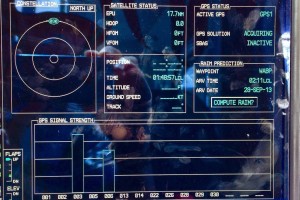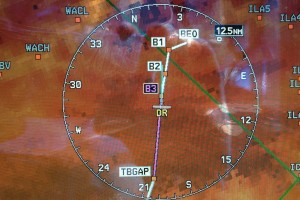 |
| Not the most comforting list of alerts… |
Now just to clear this up before you read on, GPS is our primary form of navigation out here in Papua. It allows us to follow safe, pre-calculated routes, made up of multiple tracks that help us to navigate the challenging environment of mountains and tricky weather. That’s not to say we follow them religiously, as often the en-route weather gets in the way but without GPS flying in Papua would be another level of challenging.
Anyway, this little incident happened on my first day back flying last week, having been sat at our maintenance base for a few day awaiting the completion of some paperwork for our newest Pilatus Porter. I’m always a little wary flying an aircraft that’s not flown for a few months, especially when it’s been sitting on the ground in the tropics (hot, humid, salty air); past experiences have taught me it’s always going to involve various bits of avionics failing on you. However, the ferry flight from Biak to Timika went fine and there was little warning of what was to happen the following morning.
There wasn’t even any warning I was about to lose all GPS navigation. Just a nice female voice announcing “TAWS not available” in a rather abrupt tone, followed by various CAS (Crew Alerting System) messages appearing on the PFD (Primary Flight Display). TAWS stands for Terrain Awareness and Warning System and is considered a significant enough problem that you get a spoken audio announcement it’s offline, along with the master caution light and alarm.
 |
| No satellites on GPS 1 or 2 |
However, although TAWS going offline was the thing I was initially being made aware off, the various other messages regarding the loss of GPS were more of a concern. A twist through the pages of the MFD (Multi-function Display) to the AUX pages revealed that the reason for the TAWS being offline, was because I now had no GPS signal on either system. As with most things in aviation, there’s more than one system for all the important bits, so to lose both GPS systems was rather unfortunate.
 |
| Garmin GPS in Dead Reckoning mode |
First things first, fly the aircraft. The route from Timika to Beoga is one I’ve done dozens of times now and thus I’m pretty familiar with the area. As I was less than ten minutes out and the weather was fairly nice, with only a few clouds about, I elected to continue and land in Beoga to see if shutting everything down on the ground would get the GPS working again.
A rather nifty function of the Garmin G950 is that if it does lose GPS, it reverts to what Garmin call DR (dead reckoning) mode. To quote the handbook “In DR Mode, the G950 uses its last-known position combined with continuously updated airspeed and heading data (when available) to calculate and display the aircraft’s current estimated position.”. Clever stuff and surprisingly accurate; it remained active until I’d landed and showed us directly over Beoga.
 |
| Where are we again? |
Unfortunately for me, shutting down and restarting didn’t resolve the GPS failure problems so I was faced with returning to Timika with no GPS. This time there was no dead reckoning mode so I had to go fully old school and fly totally visually, cross checking my position with the features on the ground. This is where experience starts to count, as the whole way back to Timika was a non-event really. Once the airport’s VOR was tuned in, I simply homed in for the last 30nm or so after clearing the ridge line from the mountains to the flatlands of the south.
An interesting experience having to fly without the GPS and actually good practice. I’m happy to say I didn’t feel too uncomfortable flying around without it but certainly wouldn’t want to make a habit of it. Hopefully that’ll be the first and last time I get a double failure. Meanwhile, the aircraft’s now back in maintenance to get to the bottom of why the GPS keeps dropping out.
Discover more from Matt Dearden
Subscribe to get the latest posts sent to your email.

A follow up to this story, it turns out the problem with the GPS dropping off-line was traced to the rotating beacon. This particular aircraft is our only G950 equipped aircraft with a rotating beacon. Pilatus/Garmin are looking into it but for now the beacon’s had it’s CB pulled and locked off until a proper solution is found.
Old thread, but interesting, as I had a anticollision strobe on the glider tow-plane that I built de-sensitize the comms radio, before I changed to a different strobe. Is the rotating beacon really a rotating, continuous, red light, or a flashing device? These create a lot of radio noise, enought to wipe out the faint GPS sat’s signals. What was the solution found / applied?
The beacon is really a continuous red light with a spinning reflective shield to make it flash. I don’t actually know what the solution was in the end but it’s fixed now and both GPSs work fine with the rotating beacon on.
Hi Matt,
I thought of that today: a rotating beacon has a motor to turn the reflector, which can create radio noise nearby and along the supply cable. A simple R/C (resistor/capacitor) combination and a few RF chokes (ferrite beads) right at the motor normally take these parasitic signals out. (I used to be a TV technie before going into IT – now completely different: renewable energies in the French outback, and som (too little) mountain flying.
Have safe flights, with GPS’s always operational.
I have really enjoyed every one of your blogs!
Best of luck with your aviating!